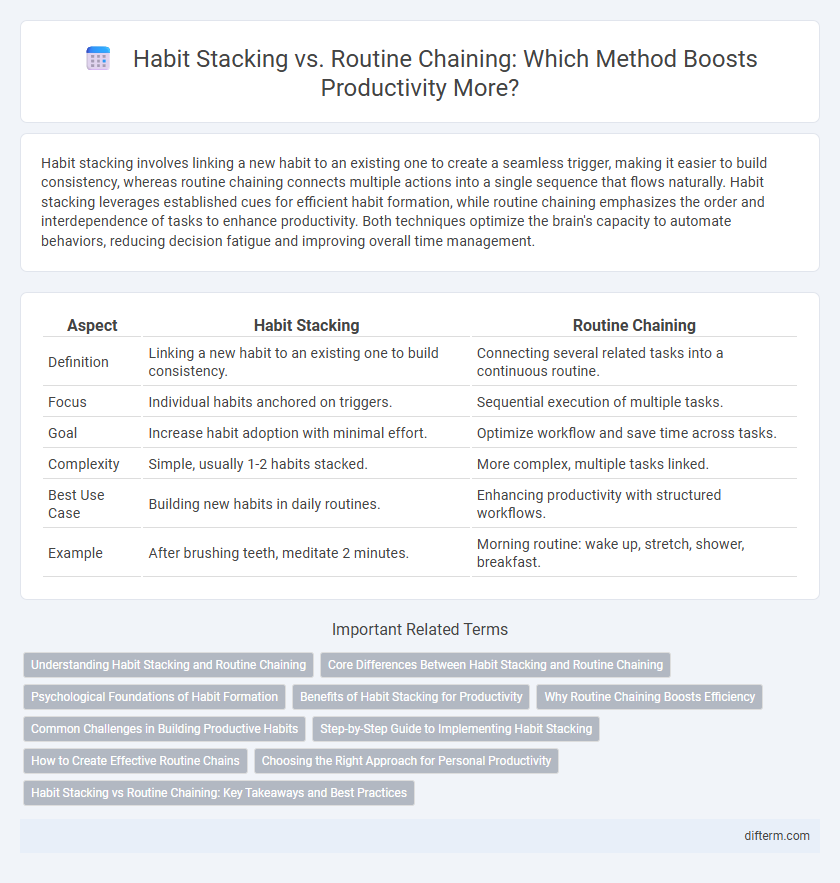Habit stacking involves linking a new habit to an existing one to create a seamless trigger, making it easier to build consistency, whereas routine chaining connects multiple actions into a single sequence that flows naturally. Habit stacking leverages established cues for efficient habit formation, while routine chaining emphasizes the order and interdependence of tasks to enhance productivity. Both techniques optimize the brain's capacity to automate behaviors, reducing decision fatigue and improving overall time management.
Table of Comparison
| Aspect | Habit Stacking | Routine Chaining |
|---|---|---|
| Definition | Linking a new habit to an existing one to build consistency. | Connecting several related tasks into a continuous routine. |
| Focus | Individual habits anchored on triggers. | Sequential execution of multiple tasks. |
| Goal | Increase habit adoption with minimal effort. | Optimize workflow and save time across tasks. |
| Complexity | Simple, usually 1-2 habits stacked. | More complex, multiple tasks linked. |
| Best Use Case | Building new habits in daily routines. | Enhancing productivity with structured workflows. |
| Example | After brushing teeth, meditate 2 minutes. | Morning routine: wake up, stretch, shower, breakfast. |
Understanding Habit Stacking and Routine Chaining
Habit stacking involves linking a new habit to an existing one to create a seamless workflow, leveraging established neural pathways to increase consistency. Routine chaining organizes multiple habits into a structured sequence where each action triggers the next, reinforcing behavioral patterns through predictable cues. Understanding these techniques enhances productivity by streamlining habit formation and minimizing decision fatigue.
Core Differences Between Habit Stacking and Routine Chaining
Habit stacking involves linking a new habit directly to an existing habit to create a seamless behavioral trigger, enhancing automaticity and ease of adoption. Routine chaining connects several sequential actions into a cohesive routine where each step serves as a cue for the next, promoting complex behavior sequences. The core difference lies in habit stacking's emphasis on attaching single habits to established ones, while routine chaining organizes multiple related behaviors into structured, continuous processes.
Psychological Foundations of Habit Formation
Habit stacking leverages the psychological principle of associative learning by linking a new habit to an existing behavior, making it easier to trigger the desired action through established neural pathways. Routine chaining relies on sequence-based reinforcement, where completing one task provides immediate cues and intrinsic reward to initiate the next, enhancing behavioral momentum and habit consolidation. Both techniques utilize dopamine-driven reward loops and contextual cues fundamental in habit formation, yet habit stacking emphasizes environmental triggers, while routine chaining focuses on internal task sequencing for sustained productivity.
Benefits of Habit Stacking for Productivity
Habit stacking enhances productivity by leveraging existing habits to create seamless, automatic routines that reduce decision fatigue and increase mental bandwidth. This technique strengthens neural associations, making new productive behaviors more sustainable and easier to maintain over time. Habit stacking's incremental approach ensures consistent progress, boosting efficiency without overwhelming the individual.
Why Routine Chaining Boosts Efficiency
Routine chaining boosts efficiency by creating a seamless flow of tasks that minimizes decision fatigue and transition time between activities. Unlike habit stacking, which links new habits to existing ones, routine chaining builds an interconnected sequence of actions that enhances focus and momentum. This structured approach leverages cognitive automation, allowing the brain to operate with less conscious effort and higher productivity.
Common Challenges in Building Productive Habits
Habit stacking and routine chaining both face challenges such as maintaining consistency and avoiding overwhelm, especially when new habits lack clear triggers or immediate rewards. Habit stacking relies heavily on linking a new habit to an existing one, but disruptions in the base habit can break the chain, while routine chaining demands sequential execution, which can lead to fatigue or skipped steps. Common obstacles include poor habit cue identification, insufficient motivation, and underestimating the complexity of integrating multiple habits into daily life.
Step-by-Step Guide to Implementing Habit Stacking
Habit stacking involves linking a new habit directly to an existing one, making the implementation seamless by leveraging established neural pathways. To effectively implement habit stacking, identify a consistent trigger behavior, define a clear and specific new habit, and immediately follow the existing habit with the new one for maximum reinforcement. Tracking progress daily and adjusting the stack based on ease and context ensures the habit integrates smoothly into your productivity routine.
How to Create Effective Routine Chains
Creating effective routine chains involves linking small, manageable habits that flow naturally from one to the next, ensuring minimal decision fatigue and maximizing adherence. By identifying triggers within existing behaviors and sequencing actions logically, individuals can build seamless chains that reinforce productivity throughout the day. Consistency in timing and environment further solidifies routine chains, making them more sustainable than isolated habit stacking techniques.
Choosing the Right Approach for Personal Productivity
Habit stacking leverages existing habits by linking new behaviors directly to them, enhancing consistency and ease of adoption. Routine chaining organizes consecutive actions into a structured sequence, optimizing workflow for tasks that require step-by-step completion. Selecting between habit stacking and routine chaining depends on individual goals and task complexity, with habit stacking favoring incremental habit formation and routine chaining supporting comprehensive task execution.
Habit Stacking vs Routine Chaining: Key Takeaways and Best Practices
Habit stacking involves linking a new habit to an established one, leveraging existing neural pathways for smoother integration and increased adherence. Routine chaining connects multiple small actions into a sequential flow, creating a comprehensive behavior pattern that drives complex goal achievement. Effective productivity strategies emphasize starting with habit stacking for simplicity and gradually building routine chains for multifaceted tasks, ensuring sustainable progress and measurable results.
Habit stacking vs Routine chaining Infographic

 difterm.com
difterm.com